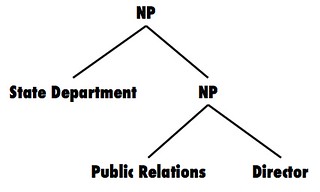Though, unfortunately, it is easy to blather about. And that’s what literary critics mostly do, talk around it, but never actually examine it.
To some extent I think that the interpretive mindset renders formal features invisible. It’s a professional blindness. But even without that mindset firmly bolted on, we need help in seeing formal features. It’s not enough to have an inquiring mind and a pure heart. Not only do you have to forget about interpreting the text, you’ve got to objectify the text. That requires an intellectual action of some kind.
I figure I got two things from Lévi-Strauss [2]: 1) permission to objectify the text, and 2) some tools to achieve it. That first is where critics balked. As for the second, I’m thinking of feature tables, quasi-formal equations and diagrams, and the search for binary opposition. The last is the only thing that stuck in literary criticism, but objectification gives it a different valence.
A few years ago Mark Liberman made some remarks on linguistic form that are germane [1]. Liberman isn’t a literary critic; he’s a linguist. He’s interested, not in the form of literary text, but in the form of sentences, and in the difficulty that students have in learning to analyze it.
I've noticed over the years that a surprisingly large fraction of smart undergraduate students have a surprising amount of trouble with what seems to me like a spectacularly simple-minded idea: the simple parallelism between form and meaning that linguists generally call "recursive compositionality", and compiler writers call "syntax-directed translation".A trivial example of this would be the relation between form and meaning in arithmetic expressions: thus in evaluating (3+2)*5, you first add 3 and 2, and then multiply the result by 5; whereas in evaluating 3+(2*5), you first multiple 2 and 5, and then add 3 to the result. Similarly, in evaluating English complex nominals, the phrase stone traffic barrier normally means a traffic barrier made out of stone, not a barrier for stone traffic, and thus its meaning implies the structure (stone (traffic barrier)). A plausible way to think about this is that you first create the phrase traffic barrier, and the associated concept, and then combine that — structurally and semantically — with stone. In contrast, the phrase steel bar prices would most plausibly refer to the prices of steel bars, and thus implies the structure ((steel bar) prices).There are many formalisms for representing and relating linguistic form and meaning, but all of them involve some variant of this principle. It seems to me that understanding this simple idea is a necessary pre-condition for being able to do any sort of linguistic analysis above the level of morphemes and words. But when I first started teaching undergraduate linguistics, I learned that just explaining the idea in a lecture is not nearly enough. Without practice and feedback, a third to a half of the class will miss a generously-graded exam question requiring them to use parentheses, brackets, or trees to indicate the structure of a simple phrase like "State Department Public Relations Director".In fact, even a homework assignment with feedback is not always enough, even with a warning that the next exam will include such a question. For some reason that I don't understand, this simple analytic idea is surprisingly hard for some people to grasp.
So, “State Department Public Relations Director”: ((State Department) ((Public Relations) Director)). Or:
I'd say that anyone with a serious interest in describing the structure of literary texts, or movies for that matter, has to be thoroughly familiar with this notion. And, Liberman is correct, it's not enough simply to see the concept explained and demonstrated. You have to work through examples yourself.
[1] Mark Liberman. Two Brews. Language Log. Accessed Nov. 29, 2015. URL: http://languagelog.ldc.upenn.edu/nll/?p=2100
[2] William Benzon. Beyond Lévi-Strauss on Myth: Objectification, Computation, and Cognition. Working Paper. February 2015. 30 pp. URL: https://www.academia.edu/10541585/Beyond_Lévi-Strauss_on_Myth_Objectification_Computation_and_Cognition

I wouldn't be surprised at all. As for the accuracy of the diagram, yes "state department" and "public relations" need to be dealt with and there are other details as well. But the digram I've got is sufficient to make the point I was after.
ReplyDelete